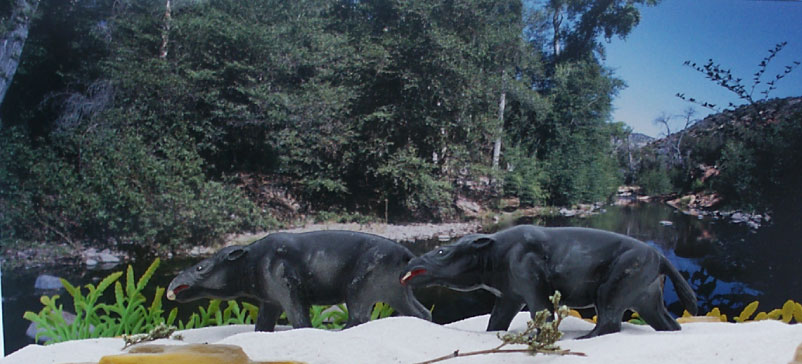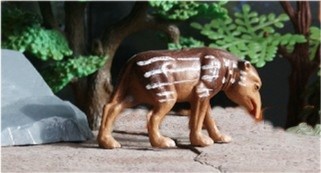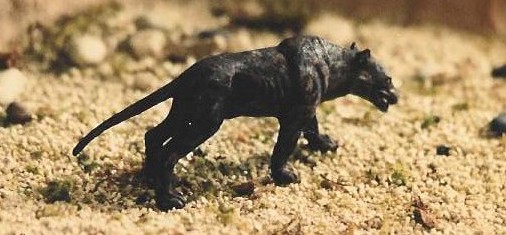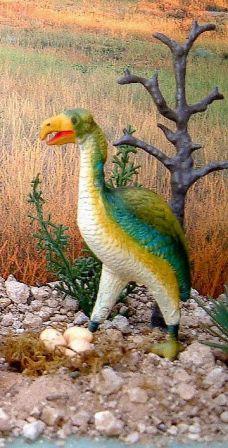From the Dinosaur Collector
The Late Eocene 37.2 to 33.7 mya.
update082007
Age of Mammals Diorama More Diorama
| Back Early Eocene | NEXT |
Next Palocene |
Africa is still charactisied by a rainy tropical climate common from the start of the Eocene warming. Fossils from Egypt show animals adapted to a semi aquaitic mangrove environment. Elepahants and primates develope here and radiate to other continets. Moertherium the ancestor of the elephant family. The name refers to lake Moeris in Egypt where the fossils were found. This sheep sized animal is thought to have been semi aquatic like hippo of today. The were featured in the Eocene segment of the Walking with Prehistoric Beasts documentary.

Moertherium from Starlux.
Arsinoitherium lived in small groups and would have been in the water most of the time like modern Hippos. It couldn't straighten its legs, suggesting they were better for wading and swimming than for walking.

The large pair of horns that male Arsinoitherium
possessed were found to contain blood vessels which indicate that the horns
could have been covered by skin, much like the small ossicones found on the
head of the modern day giraffe. best know from finds in Egypt the spread as
far a Mongolia before disapearing in the Oligocene.

Photo and custom figure from Fred Hinojosa.
Paleotherium alternately Palaeotherium (old beast) an early off shoot of the line that lead to horses. It lived from Eocene to the Early Oligocene. Palaeotheres were horse-like animals.

Starlux Paleotherium
At the beginning of the Paleozoic giant birds like Diatryma are found in Europe, North America, Africa, South America and Australia. Only Asia which was cut off from Europe by an inland sea has no giant birds. The land bridge between North America and Asia was covered in ice. In Asia there are no giant birds and mammalian predators evolve. At the end of the period the climate changes creodonts are able spread to North America, Europe and Africa.
One branch of mesonychids may have survived to this day in the oceans: the whales. Molecular biologists link them generally to the even-toed ungulates like Hippos, but many paleontologists favor a descent from the Mesonychia. The most primitive whales from early Eocene coastal deposits in Asia show some striking similarities to mesonychids. It seems likely that is is a case of convergent evolution.
Bullyland Andrewsarchus, from there mammal series. Bullyland has a large line of well done prehistoric mammals.
Andrewsarchus the last of the Asian
mesonychids was a truly spectacular beast . Only one specimen of this
animal is known, but it is a skull almost a meter long, more than twice
the size of any bear that has ever lived. If the rest of the animal were
also bear like, it would have been about four meters long, two meters
high at the shoulder, and weighed almost four times as much as the largest
known bear. |
The mesonychid carnivore Andrewsarchus seeks
shelter in the woods. It is a fierce animal up to 13 feet long and
it is primarily a scavenger but it will attack larger animals. It may
have been omniverous some of th eblunt teeth seem more adapted to plant
eating. |
 |
|
| The striped Starlux and the kaiyodo Dino Tales Andrewsarchus. DinoTales has only done a few mammals but they are excellent figures. | Riff's Lost World Starlux
Andrewsarchus. Custom diorama submitted by Riff Smith
photo by Bob. |
| In North America, Brontotheres replaced the earlier Uintatheres as the largest herbivores. Smaller forms persist through the Eocene but there is a progression in size so that the later brontotheres as very large over 8 feet in height. They develop paired horns over the noses. The horns vary by speices and between the sexes. This suggests they were social animals and used the horns in agonistic displays. Like most of the herbivores of the Eocene they were browsers. | Brontotherium was 8 ft high at the shoulder and lived in North America. Recently Brontotherium and merged with Megacerops and the fossils have been redated from the Oligocene to the Late Eocene. Like many Eocene browsers they were not able to adapt fast enough the spread of the grasslands at the end of the Eocene. They are related most closely to horses and more distantly to rhinos. | |
 |
||
Brontotherium
from Ral Partha metal figure
line and Nabisco premiums. |
Megacerops From Royal Saskatchewan Museum in Regina, Saskatchewan diorama. Picture by Sean Bell. |
 |
The world at the end of the Eocene become colder and drier. The big birds are still found in South America and Australia but die out everywhere else. It is implied that the mammals replaced birds which weren't adaptable. In South America the phorasracids linger until the last ice ages when South America is connected to North America by a land bridge. Initially they do very well spreading north but die with the last of the mega fauna. Creodonts are replaced by modern carnivores. The large browsers and avian predators die out at the end of the Eocene. Many have no close living relatives. The end of the Mesozoic opened up new niches for the placental to diversify into to. The most successful families these early animals die out and are not related to modern families. Being first may not be that important. |
MPC Diatryma Photo and custom figure from Fred Hinojosa.